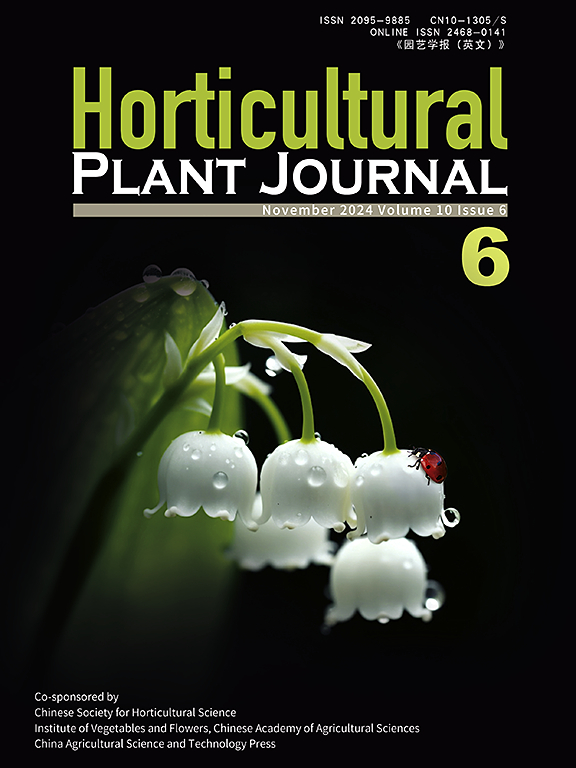联合应用气化滤饼和马齿苋,提高咸水灌溉下的土壤质量和番茄产量
IF 5.7
1区 农林科学
Q1 HORTICULTURE
引用次数: 0
摘要
咸水(BW)灌溉可能会导致土壤质量恶化,从而降低作物产量。在此,我们研究了在咸水灌溉条件下施用气化滤饼(GFC)、间作套种(PO)及其组合对土壤质量、植物养分吸收和番茄产量的影响。评估的处理包括:(i) 淡水灌溉(对照组);(ii) 生物量灌溉;(iii) 生物量灌溉下施用 GFC(生物量 + GFC);(iv) 生物量灌溉下与 PO 间作(生物量 + PO);(v) 生物量灌溉下 GFC 和 PO 的联合施用(生物量 + PO + GFC)。总体而言,使用 BW 灌溉会导致土壤质量(通过土壤质量指数(SQI)进行评估,该指数综合了盐分、养分供应和微生物活动等一系列关键土壤特性)和作物产量下降。然而,在进行 BW 灌溉时,施用 GFC 成功地防止了土壤盐渍化。此外,间作 PO 还降低了土壤钠吸附率,提高了植物对养分的吸收。因此,与其他 BW 相关处理(即 BW、BW + GFC 和 BW + PO)相比,BW + GFC + PO 处理的番茄产量普遍较高。与 BW 相比,BW + GFC + PO 处理在四个种植季的总产量平均提高了 24.7%。此外,BW + GFC + PO 处理的果实质量指数(FQI)始终最高。综上所述,在 BW 灌溉条件下,联合施用 GFC 和 PO 能有效提高土壤质量和作物产量。本文章由计算机程序翻译,如有差异,请以英文原文为准。
Combined application of gasification filter cake and Portulaca oleracea to promote soil quality and tomato yields under irrigation with brackish water
Brackish water (BW) irrigation may cause soil quality deterioration and thereby a decrease in crop yields. Here we examined the impacts of applying gasification filter cake (GFC), intercropping with (PO), and their combination on soil quality, nutrient uptake by plants and tomato yields under BW irrigation. The treatments evaluated included (i) freshwater irrigation (Control), (ii) BW irrigation, (iii) GFC application under BW irrigation (BW + GFC), (iv) intercropping with PO under BW irrigation (BW + PO), and (v) the combined application of GFC and PO under BW irrigation (BW + PO + GFC). Overall, the use of BW for irrigation resulted in a decline in both soil quality (assessed by a soil quality index (SQI) integrating a wide range of key soil properties including salinity, nutrient availability and microbial activities) and crop yields. Nevertheless, when subjected to BW irrigation, the application of GFC successfully prevented soil salinity. Additionally, the intercropping of PO decreased the soil sodium adsorption ratio and improved the absorption of nutrients by plants. As a result, the BW + GFC + PO treatment generally showed higher tomato yield as compared to other BW-related treatments (i.e. BW, BW + GFC and BW + PO). Compared to BW, the BW + GFC + PO treatment had an average increase of 24.7% in the total fruit yield of four Cropping Seasons. Furthermore, the BW + GFC + PO treatment consistently exhibited the highest fruit quality index (FQI). Taken together, the combined application of GFC and PO is effective in promoting soil quality and crop yields under BW irrigation.
求助全文
通过发布文献求助,成功后即可免费获取论文全文。
去求助
来源期刊

Horticultural Plant Journal
Environmental Science-Ecology
CiteScore
9.60
自引率
14.00%
发文量
293
审稿时长
33 weeks
期刊介绍:
Horticultural Plant Journal (HPJ) is an OPEN ACCESS international journal. HPJ publishes research related to all horticultural plants, including fruits, vegetables, ornamental plants, tea plants, and medicinal plants, etc. The journal covers all aspects of horticultural crop sciences, including germplasm resources, genetics and breeding, tillage and cultivation, physiology and biochemistry, ecology, genomics, biotechnology, plant protection, postharvest processing, etc. Article types include Original research papers, Reviews, and Short communications.
 求助内容:
求助内容: 应助结果提醒方式:
应助结果提醒方式:


